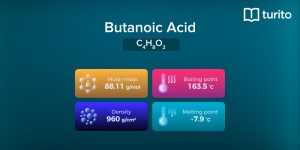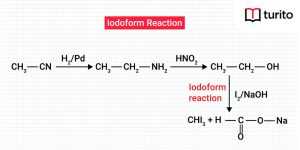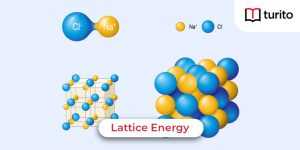Can you tell which is the most abundant gas in the atmosphere? Nitrogen? Yes! Nitrogen is the most abundant gas in the atmosphere. It makes up about 78% of the volume in the atmosphere.
Nitrogen occurs in the diatomic, i.e., dinitrogen or N₂ form. You have read the periodic table and noticed that the name generally knows most groups of their first member. So, can you guess the name of the group containing nitrogen gas? What happens when nitrogen reacts with hydrogen? What is the name given to the product thus formed? What is ammonia? What are its properties?
This section will aid you in learning more about ammonia, a product formed by reacting nitrogen and hydrogen.
What Is Ammonia?
Due to the electronegativity and small size of nitrogen, it can form many compounds with other periodic table elements. Ammonia is one of them. It has its own unique properties and uses.
What is ammonia? Ammonia is the product or compound formed by the bonding or reaction between nitrogen and hydrogen. It is one of the simplest compounds formed by these two elements. The molecular ammonia formula is NH₃.
It is available in small amounts in the soil and air. In the soil, it is formed by decomposing nitrogenous organic things, i.e., urea. Ammonia has many environmental and industrial uses. It is the building block of many medicines and cleaning products.
Structure of Ammonia
According to the Lewis structure, the nitrogen atom is surrounded by four electron pairs. These four electron pairs include three bond pairs with three H-atoms and one lone pair an N-atom. As a result, they form the spatial arrangement of these four electron pairs around the N-atom tetrahedral.
Because of one lone pair at one of the four vertices of the tetrahedron, a lone pair-bond pair repulsion occurs. Since this repulsion is greater than bond pair-bond pair repulsion, the bond angle of ammonia decreases from 109.5° to 107.5°. Therefore, the shape of the ammonia formula NH₃ molecule is not tetrahedral but gets distorted and becomes trigonal pyramidal.

Preparation of Ammonia
There are two ways to prepare ammonia, i.e., laboratory and commercial.
1. Laboratory method:
- By heating ammonium sulphate and sodium hydroxide (or other strong bases).
(NH₄)₂SO₄ + 2NaOH + Heat → 2NH₃ + 2H₂O + Na₂SO₄
- By heating slaked lime and ammonium chloride.
2NH₄Cl + Ca(OH)₂ + Heat → 2NH₃ + 2H₂O + CaCl₂
- When water reacts with metal nitrides.
Mg₃N₂ + 6H₂O → 3Mg(OH)₂ +2NH₃
2. Commercial method:
On an industrial scale, ammonia is manufactured by Haber’s process.
N₂ (g) + 3H₂ (g) ⇌ 2NH₃ (g)
This reaction is feasible at low temperature, high pressure, and in the presence of a catalyst.
Physical Properties of Ammonia
- It is a colourless gas with a predictable pungent smell.
- It causes tears in the eyes.
- The ammonia formula is NH₃.
- The ammonia molar mass is 17.031 g/mol.
- The density of ammonia is 0.68 g/cm³. Hence, it is lighter than air.
- It is extremely soluble in water.
- Liquid ammonia boils at 239.6K, while its melting point is 198.4K.
- It gets easily liquefied by cooling under pressure.
- It gets easily liquefied by cooling under pressure.
- When vaporized, liquid ammonia causes intense cooling.’
Chemical Properties of Ammonia
- It has basic nature. However, this basic nature is very weak, but it is due to the formation of OH⁻ ions.
- It reacts with heavy metal salt solutions and forms their hydroxide precipitates.
FeCl₃ + 3NH₄OH → Fe(OH)₃ ↓ + 3NH₄Cl
- It behaves as a Lewis base.
NH₃ + BF₃ → H₃N→BF₃
- It gets oxidised to nitrogen when it is passed through bromine water.
8NH₃ + 3Br₂ → N₂ + 6NH₄Br
- With sodium hypochlorite, it gets oxidised and forms hydrazine.
2NH₃ + NaOCl → NH₂.NH₂ + NaCl + H₂O
- Liquid ammonia acts as a solvent in many chemical reactions.
2NH₃ ⇌ NH₄⁺ + NH₂⁻
- It forms amides and releases hydrogen gas when it passes over molten metals like sodium or potassium.
2Na + 2NH₃ → 2NaNH₂ + N₂
- Due to the high electronegativity of nitrogen, the N-H bond is quite polar. Hence, the ammonia formula NH₃ molecule undergoes intermolecular H-bonding.
Uses of Ammonia
Ammonia has various uses. Some of them are
- In the Solvay process, ammonia is used to manufacture sodium carbonate.
- In Ostwald’s process, the production method of nitric acid, NH₃, is employed.
- Ammonia is used in manufacturing fertilisers such as ammonium nitrate, ammonium sulphate, diammonium phosphate, urea, etc.
- It is used in the manufacture of rayon and urea.
- Ammonia is used as a cleaning agent for removing grease, etc., from glass surfaces and furniture.
- Ammonia is used as a refrigerant in ice plants.
- It is an important reagent and is used as a solvent in the laboratory.
- Household ammonia, i.e., ammonium hydroxide, is used to clean various surfaces.
- It assists in breaking down the household grime or stains from animal fats or vegetable oils.
- Ammonia is used to purify water supplies.
- It works as a building block in producing explosives, plastics, pesticides, fabrics, and dyes.
How to Test Ammonia?
Whether a reaction releases ammonia or the compound is given to you is ammonia or not, you need to perform some test to verify it. Some tests that can help you in detecting the presence of ammonia are
1. Litmus test:
As ammonia has a basic nature, it turns moist red litmus paper into the blue.
2. Turmeric paper:
Due to its basic character, ammonia changes the yellow turmeric paper into brown.
3. Test with concentrated hydrochloric acid:
A drop of concentrated hydrochloric acid (HCl) produces dense white fumes of NH₄Cl, i.e., ammonium chloride.
4. With chloroplatinic acid:
When ammonia is treated with chloroplatinic acid, it gives a yellow precipitate.
H₂PtCl₆ + 2NH₃ → (NH₄)₂PtCl₆
5. With Nessler’s reagent:
It gives a brown precipitate with Nessler’s reagent, i.e., an alkaline solution of K₂HgI₄.
6. With copper sulphate solution:
With copper sulphate solution, ammonia gives a deep blue solution.
Occurrence of Ammonia Beyond Earth
Ammonia has been detected to be present throughout the Solar System. On giant planets like Jupiter and Saturn, it is present with other gases like methane, helium, and hydrogen. Frozen crystals of ammonia are detected on Saturn’s surface.
Ammonia is also present on the two moons of Mars. Ammonia on small bodies in the Solar system obeys a geologically significant antifreeze character. It is because when ammonia is mixed with water, it reaches a melting point as low as −100°C.
Natural Occurrence of Ammonia
Ammonia is present in nature in trace amounts. It is derived from nitrogenous animal wastes and vegetable matter. The kidneys secrete ammonia to neutralise the excess acid production. Ammonia and its salts are also present in rainwater in minor concentrations. Ammonium bicarbonate crystals are present in the Patagonia guano.Ammonium chloride (sal ammoniac) and ammonium sulphate, i.e., ammonia salt, are abundant in volcanic regions. Ammonium salts spread through fertile soil and seawater.
Conclusion
Ammonia is naturally present in surface water, groundwater, and domestic sewage. It is assembled largely by the oxidation-reduction of organic nitrogen-containing compounds and the hydrolysis of urea. In water bodies, it is present naturally by reducing nitrates under anaerobic conditions.
It is an important source of nitrogen for all living beings. It works both as a metabolic input and metabolic waste in the biosphere. In the Earth’s atmosphere, ammonia is also detected in the atmosphere of giant planets in space.
Frequently Asked Questions
1. Is ammonia exposure harmful to health?
A. Ammonia is a corrosive compound. The seriousness of health effects depends on the dose, route of exposure, and duration.
- Exposure to the high ammonia levels in the air causes immediate burning of the eyes, nose, throat, and respiratory tract. It can result in lung damage, blindness, or death.
- Breathing lower concentrations of ammonia can cause throat and nose irritation and coughing.
- Consuming normal ammonia levels can cause burns to the throat, mouth, and stomach. Eye contact or skin with concentrated ammonia can also cause burns and irritation.
2. What are the aftereffects of inhaling ammonia?
A. When inhaling high amounts of ammonia, the most common symptoms include acute nose, throat, and respiratory tract inflammation. It may potentially lead to respiratory distress or respiratory failure. If the concentration of ammonia in the atmosphere is low, irritation of the throat and nose are common side effects.
3. What are the normal ammonia levels in the blood samples?
A. The normal ammonia levels in the blood samples are 15 to 45 µ/dL (11 to 32 µmol/L). The normal ammonia levels are:
- Children older than two years (enzymatic): 19 to 60 mcg/dL
- Toddlers and infants, from 10 days to 2 years old (enzymatic): 68 to 136 mcg/dL
- Age 0 to 10days (enzymatic): 170 to 341 mcg/dL
- Adults: 10 to 80 mcg/dL
If the test results show higher than normal ammonia levels, you may suffer from Reye’s syndrome or liver disease.
4. What steps should be followed if a large part of the body is exposed to ammonia?
A. If ammonia is spilt on a large part of your body, follow the given steps.
- Remove the clothes as quickly as possible and seal them in a plastic bag tightly.
- Store the bag with clothes stained with ammonia away from others’ reach.
- If you are not able to remove clothes quickly, cut them.
- If ammonia is spilt on your skin, wash it with a large amount of water and soap.
- If required, ask for medical consultation quickly.

Relevant Articles
Butanoic Acid – Structure, Properties, Uses
Butanoic Acid The carboxylic acid, butanoic acid, has the structural …
Butanoic Acid – Structure, Properties, Uses Read More »
Read More >>What is Iodoform? Characteristics and Uses
Iodoform The formula for Iodoform is CHI3. It is biotic …
What is Iodoform? Characteristics and Uses Read More »
Read More >>Lattice Energy – Explanation, Factors & Formulas
Lattice Energy Lattice energy evaluates the intensity of the ionic …
Lattice Energy – Explanation, Factors & Formulas Read More »
Read More >>Lead Acetate – Definition, Properties, Uses
Lead Acetate Have you ever licked lipstick when you sketch …
Lead Acetate – Definition, Properties, Uses Read More »
Read More >>




















Comments: